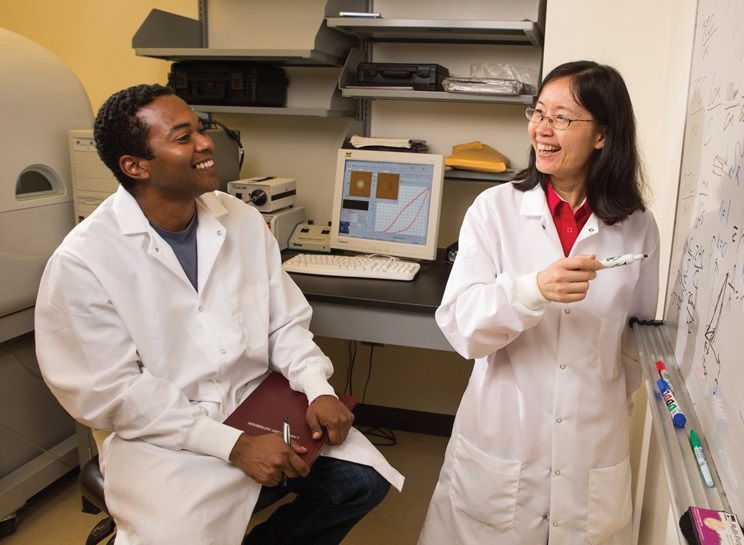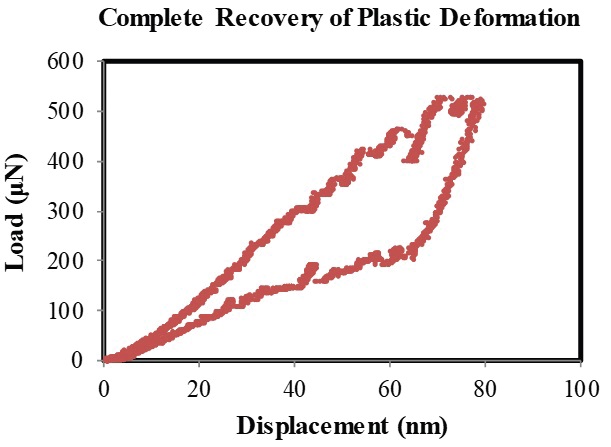TLT: What are the significances of nanoscale surface engineering for tribological applications?
Zou: The significance lies in two aspects: (1.) enables new surface properties that macro- or microscale surface engineering cannot achieve and (2.) these properties can solve existing application challenges and create new products.
It is well known that surface macro- and microtextures can provide improved tribological properties in several different ways. They reduce friction and adhesion between two contacting surfaces with relative motion by reducing their real area of contact; they increase hydrodynamic lifting force in bearings, mechanical seal and artificial hip joints by providing numerous converging gaps; they can store lubricant under starved or mixed lubrication condition and entrapping wear debris.
Nanoscale surface engineering offers several new opportunities that traditional macro- or microscale surface engineering cannot provide. First, reducing the texture size from microscale to nanoscale could increase the number of textures within a unit contact area by several orders of magnitude. This is especially important when device size gets smaller and smaller such as in microelectromechanical systems (MEMS), which leave little room for larger-scale surface textures. Adhesion/stiction, friction and wear are the major factors that affect MEMS production yield and product reliability due to large surface area-to-volume ratio of MEMS structures. These issues will escalate as microsystems technologies begin to transition into nanoscale. The reduced texture size provides the opportunities to increase the texture density while at the same time reduce contact area that can lead to the reduction of adhesion and friction in the dry contact conditions in MEMS. This could enable new MEMS products with sliding contact, which are currently not achievable.
Second, the increased number of textures can create many more converging gaps to increase the hydrodynamics lifting forces in lubricated contact conditions. This could be used to improve the tribological performance of traditional machine components, such as bearings, mechanical seals and engineering piston and ring assemblies. Due to the small texture sizes, the textures can be put on existing machine components without changing their dimensions.
Third and most important, nanoscale surface textures combined with appropriate surface chemistry can alter surface interactions with water and oil to create superhydrophobic/superoleophobic and superhydrophilic/superoleophilic surfaces. Superhydrophobic surfaces prevent meniscus formation between the contacting surfaces in MEMS and, therefore, reduce adhesion and friction. Superoleophilic surfaces will provide better surface lubrication. Furthermore, new surface properties such as slip flow for drag reduction, anticorrosion, self-cleaning, anti-icing and antifogging also can be realized.
Last but not the least, surface textures also can change light-surface interactions to provide anti-reflection property as well as change cell-surface interactions to promote cell adhesion or provide antimicrobial property. These additional properties enable multifunctional surfaces to be created for various industrial and biomedical applications.
In summary, nanoscale surface topography can affect many surface properties such as adhesion, friction, wetting and optical properties as well as chemical and biological compatibility of the surface. The ability to fabricate custom surface topographies with desired nanoscale features will enable the controlling of surface properties for a wide range of applications. In nature, from millions of years of evolution, many plants and animals have 3D micro- and nanoscale surface topographies that enabled them to have many useful properties, such as the slippery and self-cleaning properties of fish skins, the self-cleaning property of lotus leaves, the wear resistant skin of desert scorpion and the super adhesive property of gecko feet. Therefore, the ability to fabricate or mimic these nanoscale surface topographies will open the door for many new applications including tribological ones.
TLT: What kinds of techniques have you used to achieve nanoscale surface engineering?
Zou: I have used several techniques for nanoscale surface engineering, such as aluminum-induced crystallization (AIC) of amorphous silicon (a-Si), dip coating and e-beam lithography (EBL) combined with plasma-enhanced chemical vapor deposition (PECVD).
AIC of a-Si has been studied extensively for applications in thin film transistors, sensors, solar cells and display panels. Unlike traditional AIC of a-Si, which strives for growing large and continuous Si grains for applications in electronics and optoelectronics, my group has developed novel AIC of a-Si technique to produce isolated micro/nano-sized Si islands for potential MEMS tribological applications. The surface nanotextures can be tailored to produce superhydrophilic properties, which can then turn into superhydrophobic when coated with an octadecyltrichlorosilane self-assembled monolayer.
Dip coating is a widely used method for thin film deposition due to its low cost and simplicity as well as its suitability for coating various substrate shapes. The coating thickness can be controlled by the solution concentration and the withdrawal speed. My group has used dip coating to deposit nanometer-thick coatings from various chemical solutions and nanoparticle dispersions, such as polydopamine (PDA), SiO
2 nanoparticle and polytetrafluoroethylene (PTFE).
EBL is a nanofabrication technique that can achieve sub-10 nm resolution. It allows the control of the shape, size and position of nanostructures. EBL also can accommodate a wide range of materials and nanostructures and has been widely used to fabricate regular arrays of metallic nanoparticles. We have used EBL to template patterns in electron resist and then use metal deposition and lift-off to fabricate the metal cores of nanoscale core-shell structures (NCSSs) that we discovered to have novel mechanical properties (
1). We then coated the metal cores with harder a-Si shells using PECVD to form the NCSSs.
TLT: Can you please provide a couple of examples of successfully nano-surface engineered materials for tribological applications?
Zou: My lab has developed a variety of nanoengineered surfaces, surfaces engineered with nanoscale topographies and/or chemistries, to reduce friction and wear in tribological applications.
One example of successfully nano-surface engineered materials for tribological applications is the wear-resistant thin PTFE coatings that are enabled by a 50-nm-thick bioinspired PDA adhesive underlayer. Thin PTFE coatings have drawn great interests as solid lubricants. However, they are easily worn out due to PTFE’s linear, chain-like molecular structure and its poor adhesion to substrates. The lack of wear resistance severely limits the use of thin PTFE coatings. Economically fabricating wear-resistant thin PTFE coatings on substrate surfaces remains a great challenge. We have demonstrated that a strong PTFE coating-to-substrate adhesion can be achieved by using PDA as a thin adhesive underlayer. The wear life of the resulting dual-layer PDA/PTFE thin coatings was 500 times that of the PTFE coatings directly deposited on the substrates (
2). The coating wear life was further increased by incorporating Cu nanoparticles into the PTFE coatings. The combined effects resulted in a coating wear life three orders of magnitude greater than that of the plain PTFE (
3). In addition, the thin PDA/PTFE coating also significantly outperformed a commercial PTFE coating that is 20 times thicker. This technology is currently being commercialized for bearing applications and has received the National Science Foundation Small Business Innovation Research Phase I and II support and the support from the Department of Energy (
see Figure 1).
 Figure 1. Samuel Beckford and Min Zou founded SurfTec, LLC, to commercialize durable, low friction PTFE coatings. (Figure courtesy of Russell Cothren, University Relations, University of Arkansas.)
Figure 1. Samuel Beckford and Min Zou founded SurfTec, LLC, to commercialize durable, low friction PTFE coatings. (Figure courtesy of Russell Cothren, University Relations, University of Arkansas.)
Another example of successfully nano-surface engineered materials for tribological applications is the novel NCSSs that my group discovered that are highly deformation resistant (
see Figure 2) (
1). The NCSS is composed of a nano-sized plastically deformable metallic core covered by a hard amorphous shell with nanometer thickness. We have demonstrated that the NCSSs have a large recoverable deformation beyond elastic limit that results in no net shape change after being subjected to very high normal and shear contact stresses (
1, 4). The NCSS also showed much higher yield strength than the yield strength of either the core or the shell material natively. The large recoverable deformation and high strength of the NCSS suggest a great opportunity to design novel deformation resistant nano-textured surfaces using the NCSSs, which can enable a wide range of applications that require mechanical durability of the surface nanostructures, including MEMS.
 Figure 2. Schematic of the NCSS engineered surface. (Figure courtesy of Min Zou.)
TLT: How critical is nanoscale tribological and material testing and characterization to the implementation of nanoscale surface engineering for tribological applications?
Zou:
Figure 2. Schematic of the NCSS engineered surface. (Figure courtesy of Min Zou.)
TLT: How critical is nanoscale tribological and material testing and characterization to the implementation of nanoscale surface engineering for tribological applications?
Zou: They are critical to the implementation of nanoscale surface engineering for tribological applications. This is because the nanostructures are very small; even a light load could generate a high contact pressure that could cause the structure to deform permanently. The mechanical properties of nanostructures also can be different from those of the bulk material. Therefore, it is important to perform nanoscale tribological and materials testing using a tool that can locate individual nanostructures, apply ultralow loads on the nanostructures and measure the minute deformation caused by the applied load.
We use a state-of-the-art nanoindenter with
in-situ imaging capability to perform both scratch/friction testing to determine the friction coefficient and deformation/wear of the nanostructures and nanoindentation testing to determine the mechanical properties of the nanostructures. We use a scanning electron microscope (SEM) and an atomic force microscope to characterize the nanostructures and their deformation and wear after tribological and mechanical testing.
In the future, we will use
in-situ SEM nanotribological and nanomechanical testing tools to perform the tests while visualizing the scratch/wear and nanoindentation process to understand the wear and deformation mechanisms.
TLT: Can nanoscale surface engineered materials be used for friction reduction, antiwear or lubrication purpose?
Zou: Yes. We have demonstrated low-friction, wear-resistant thin PTFE coatings enabled by bioinspired nanometer-thick adhesive underlayer. We also have shown novel NCSSs that can sustain estimated contact pressures greater than 20 GPa without deformation and fatigue failure (
5). These nanostructures can be used for applications in MEMS. It also is possible surface texturing using nanoscale dimples will provide better lubrication and antiwear properties for bearings, mechanical seals and piston and ring assembly (
see Figure 3).
 Figure 3. Nanoindentation of a NCSS showing a complete recovery of plastic deformation after unloading. (Figure courtesy of Min Zou.)
REFERENCES
Figure 3. Nanoindentation of a NCSS showing a complete recovery of plastic deformation after unloading. (Figure courtesy of Min Zou.)
REFERENCES
1.
Tidwell, W., Scott, D., Wang, H., Fleming, R.A. and Zou, M. (2011), “Nanoindentation Study of Deformation-Resistant Al/a-Si Core-Shell Nanostructures,”
Acta Materialia,
59, pp. 6110-6116.
2.
Beckford, S. and Zou, M. (2014), “Wear Resistant PTFE Thin Film Enabled by a Polydopamine Adhesive Layer,”
Applied Surface Science,
292, pp. 350-356.
3.
Beckford, S., Mathurin, L., Chen, J. and Zou, M. (2015), “The Influence of Cu Nanoparticles on the Tribological Properties of Polydopamine/PTFE + Cu Films,”
Tribology Letters,
59: 11.
4.
Morton, B., Wang, H., Fleming, R. and Zou, M. (2011), “Nanoscale Surface Engineering with Deformation-resistant Core-shell Nanostructures,”
Tribology Letters,
42 (1), pp 51-58.
5.
Steck, J.G., Fleming, R.A., Goss, J.A. and Zou, M. (2018), “Deformation and Fatigue Resistance of Al/a-Si Core-Shell Nanostructures Subjected to Cyclic Nanoindentation,”
Applied Surface Science,
433, pp. 617-626.
You can reach Min Zou at mzou@uark.edu.